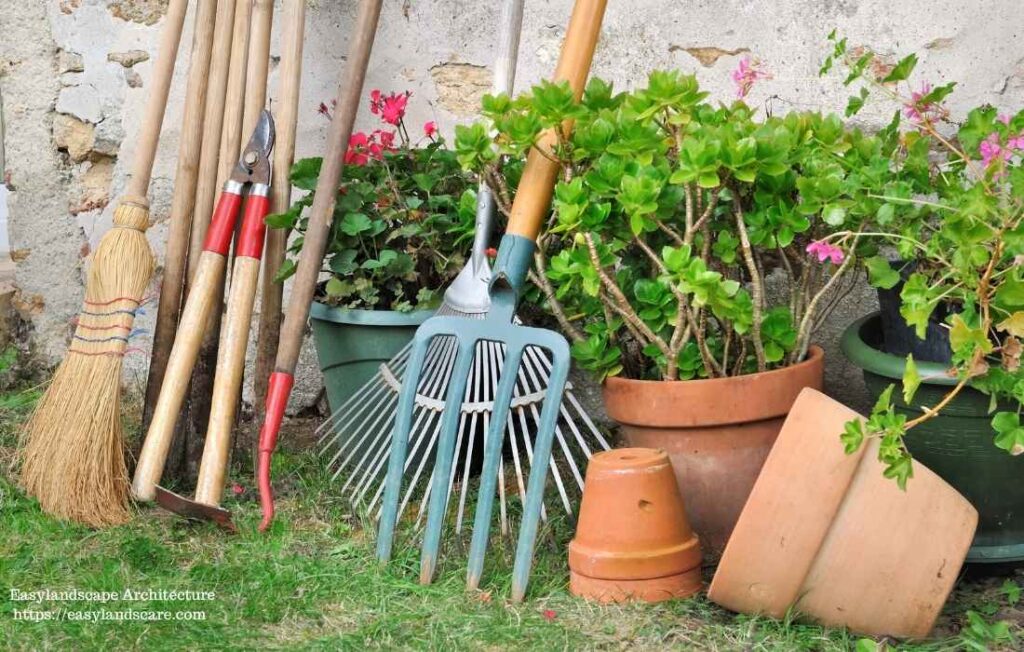Overview to Garden Maintenance
In this article, we will guide you on how to effectively perform garden maintenance with the necessary tools, so you can achieve a beautiful and thriving garden. Just like your house and car need regular care, your garden thrives with consistent attention. Without regular garden maintenance, weeds will inevitably appear, detracting from its beauty. However, keeping your garden tidy doesn’t have to be a chore. You can easily and even enjoyably maintain it yourself with the right approach. Depending on the size of your green space, a few hours of your time can make a significant difference. Think of it as a bit of exercise for you too!
Essential Tools for Garden Maintenance: Your Arsenal for a Beautiful Garden

To effectively tackle garden maintenance, having the right tools not only makes the job easier but also ensures better results and protects your plants. Let’s delve into some essential tools you’ll likely need:
The Versatile Scythe: Taming Larger Areas
The scythe is an excellent garden tool for cutting down larger patches of long grass and dense weeds efficiently. Its sweeping motion can cover ground quickly, making it ideal for initial clear-outs or maintaining larger, less manicured areas of your garden.
Precision with Hedge Clippers: Shaping Green Boundaries
Hedge clippers, whether manual or powered, are indispensable for shaping and trimming hedges, bushes, and even topiary. They allow you to create clean lines and maintain the desired form of your greenery, contributing significantly to the overall aesthetic of your garden maintenance.
Cordless Secateurs: Effortless and Precise Pruning
Cordless secateurs offer a modern and convenient way to prune smaller branches and stems. Their battery-powered operation reduces hand fatigue and allows for quick, clean cuts, promoting healthy plant growth. They are particularly useful for detailed garden maintenance tasks.
The Reliable Secateurs: Your Handheld Cutting Companion
Secateurs, or hand pruners, are a fundamental tool for any gardener. They are perfect for general cutting tasks, such as deadheading flowers, trimming small branches, and harvesting. A good pair of secateurs is essential for ongoing garden maintenance and plant health.
The Indispensable Rake: Gathering and Tidying
A rake is crucial for gathering grass clippings after mowing, collecting fallen leaves in autumn, and clearing other debris from your garden beds and lawn. Different types of rakes are available for various tasks, but a general-purpose leaf rake is a great starting point for garden maintenance.
The Mighty Shovel: Digging and More
The shovel is a versatile tool used for a variety of tasks, from digging holes for planting and transplanting to removing stubborn roots and turning soil. Its sturdy construction makes it invaluable for more demanding aspects of garden maintenance.
Step-by-Step Guide to Garden Maintenance

Let’s walk through a simple process to keep your garden looking its best through regular garden maintenance.
1. Identify and Prepare Problem Areas
First, take a walk around your garden. Identify the specific areas that need attention. This might include patches overgrown with weeds or areas with accumulated debris. Then, gather any loose rubble and garbage you find.
Expert Tip: Pay close attention to areas where objects might be hidden by grass. Mark these spots with wooden pieces to avoid damaging your tools during cleaning. This proactive step is crucial for efficient garden maintenance.
2. Tackle Grass and Weeds
Use your trimmer to cut down thick-leaved grass and weeds.
Important: Start mowing from a higher setting. This will help you avoid unexpectedly hitting hidden objects on the ground. This technique is a fundamental aspect of safe and effective garden maintenance.
For areas with heavy or difficult-to-move items, consider marking their perimeter with wooden boards. This provides both convenience and visual guidance as you work. If your trimmer struggles with thick grass, you can often switch to a metal blade for better cutting power. This also helps protect your machine from unnecessary strain, a key consideration in long-term garden maintenance.
After trimming, use your rake to clear away the cut grass and weeds. This will give you a much clearer view of the area and the progress you’re making in your garden maintenance efforts.
3. Removing Stubborn Growth
For persistent roots or unwanted plants that your scythe can’t handle, the shovel is your best friend. Dig them out carefully. This prevents new growth from these roots, a vital step in preventing future weed problems and ensuring effective garden maintenance.
4. Caring for Bushes and Hedges
Now, let’s address overgrown bushes. A useful trick is to tie together the bushes you want to remove with rope before cutting. This makes it much easier to move them to a garden shredder after you’re done cutting. Use your pruner for thicker branches. For newer shoots and general shaping of hedges, a hedge cutter is ideal for creating clean lines and promoting healthy growth, both important aspects of good garden maintenance.
5. Dealing with Clippings and Soil
If you’d like to compost the branches and leaves you’ve cut, a garden shredder will be a valuable tool. If you want to prevent new weed beds from forming, dig up any grassy soil in unwanted areas and loosen the soil around your existing plants. You can enrich the soil by adding compost to the areas you’ve dug. This not only improves soil health but also aids in better garden maintenance by suppressing weeds.
Enjoy Your Well-Maintained Garden
There you have it! With these steps, your garden will be looking neat and tidy. Regular garden maintenance, even in short bursts, will keep it that way, allowing you to fully enjoy your outdoor space.
You can access our other articles on landscape applications on our Landscape Execution category page.
 Easy Landscape Architecture plant care, plant Encylopedia, toxic plants, plant ideas
Easy Landscape Architecture plant care, plant Encylopedia, toxic plants, plant ideas 
One comment
Pingback: CLEAN THE LEAVES IN YOUR GARDEN - Easy Landscape Architecture